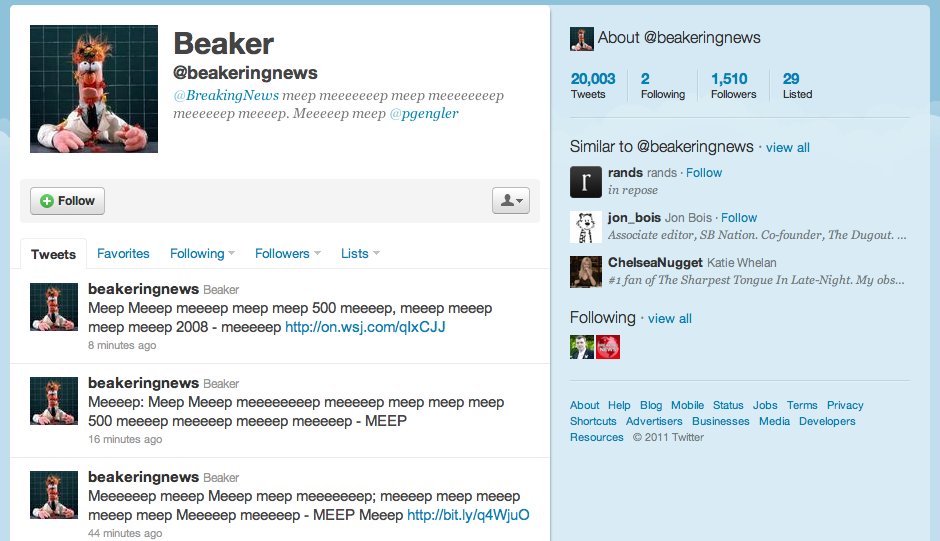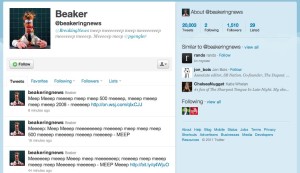I’m probably not going to follow you back on Twitter.

 Every day there are thousands of people on Twitter who follow others just in the hopes of being followed back. The questions become: why are you seeking out more followers? What do you have to offer someone who could follow you?
Every day there are thousands of people on Twitter who follow others just in the hopes of being followed back. The questions become: why are you seeking out more followers? What do you have to offer someone who could follow you?
On Twitter, most of the time, I will not follow you if you follow me; this is a social media relationship, not a casual friendship. I need to be entertained, have interesting articles shared with me, something! I’m needy, what can I say?
The old saying (can it be an old saying if Twitter is only 5 years old?) is that no one cares that you are eating a sandwich or figuring out this Twitter thing. You signed up for Twitter because you had something to say. Say it. I don’t expect everyone I follow on my personal account to follow me back. Just because I am in their audience doesn’t mean that they are in my audience.
Twitter is what you want it to be. You create your stream based on what interests you, whether that be cats, what time it is in England, or more serious updates from your favorite products, sports team, or breaking news from a Muppet. You following me doesn’t magically create an interest in what you tweet. And you shouldn’t feel bad about that.
There are many social media people who say you should follow everyone who follows you. All that does is over-inflate your following/followers ratio and creates a Twitter stream filled with a lot of noise. At that point, Twitter would become useless to you as you are bombarded with update after update. You won’t be able to keep up with it, and you’ll miss what you truly care about in all of the noise.
How does this relate to marketing for your business on Twitter? Should you follow back everyone that follows your business? No, not necessarily.
“Well, who should I follow?” you’re probably yelling at me.
Off the bat, you should be following:
- thought leaders in your industry (non-competitors if it’s a business account, anyone else if it’s under a personal account)
- products and services you use
- like-minded brands
- other accounts your business may have
Next, who interacts with you? These are your customers who love what you do so much that not only are they following you, but they are promoting your service or product, because it’s so awesome. These are your customer evangelists. Don’t stop at only following them. Acknowledge and interact with them.
Let’s look at the top two most followed celebrities on Twitter: Lady Gaga has 12,231,845 followers, and Justin Bieber has 11,482,258. On the flip side, they follow 142,307 and 116,258 people respectively. Obviously Lady Gaga and Justin Bieber aren’t on Twitter to create a back and forth conversation with their fans; it’d be impossible with all of the noise. They are there to broadcast to their fans, and that’s fine.
But let’s look at someone much smaller in comparison. A service we use daily at LyntonWeb, Fogbugz, has 2,034 followers, and they only follow 3 accounts. They are on Twitter to interact with their users. They offer support and post blog updates and feature/product releases, and that’s fine too.
Your Twitter plan, and your social media plan, need to be custom built for you; an out of the box solution will not work for everyone. Consider how people perceive your company and the type of interaction that they request on a daily basis. If you’re an agency, you want to follow your clients, thought leaders, etc. and try to interact with them when possible. If you’re a software company, you want to provide product updates and feedback for your customers, not necessarily engaging them in everyday communications.
Begin by examining your current communication strengths and how that can be converted to Twitter. If people or prospects or clients are always asking questions about your business, reach out and engage more on Twitter. If they’re always looking for feedback or support, share updated product activity with them.
As with growing your blog, growing your Twitter followers takes time. But the bottom line is if you have great content, people will find you.
This article originally appeared on LyntonWeb.